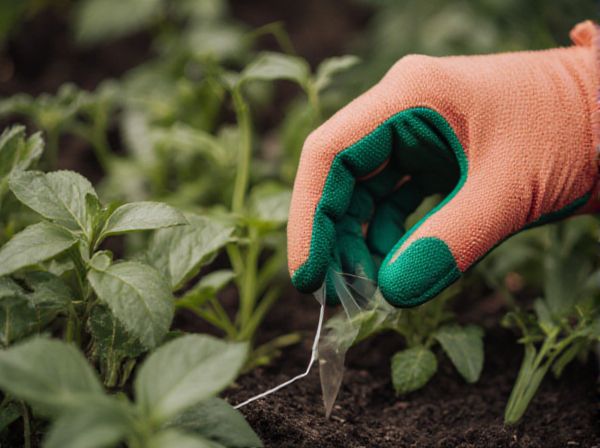
Seed tape vs Loose seed Illustration
Seed tape offers precise spacing and consistent planting depth, reducing seed waste and ensuring uniform crop growth compared to loose seed sowing. Loose seed planting provides flexibility for varied planting densities but often results in uneven germination and requires more thinning. Choosing seed tape enhances efficiency and simplifies the planting process, particularly for small-scale gardeners and row crops.
Table of Comparison
| Feature | Seed Tape | Loose Seed |
|---|---|---|
| Planting Precision | High accuracy with uniform spacing | Variable spacing, less uniform |
| Ease of Use | Simple to handle and plant | Requires careful sowing technique |
| Seed Wastage | Minimal wastage due to controlled placement | Higher wastage from scattering |
| Cost Efficiency | Typically higher upfront cost | Lower initial cost |
| Germination Rate | Consistent and higher success rate | Variable germination depending on sowing |
| Suitable Crops | Best for small seeds like carrots, lettuce | Suitable for a wide range of seeds |
| Time Efficiency | Faster planting process | More time-consuming |
Introduction to Seed Tape and Loose Seed
Seed tape offers a pre-spaced, convenient method for planting small seeds directly into soil, enhancing germination rates and reducing thinning efforts. Loose seed planting allows for more flexibility in seed quantity and placement but requires careful spacing and often additional thinning to prevent overcrowding. Selecting between seed tape and loose seed depends on the gardener's preference for precision versus planting volume control.
What is Seed Tape?
Seed tape consists of pre-spaced seeds embedded in a biodegradable strip, designed to simplify planting and ensure even seed distribution. This method reduces seed wastage and promotes uniform seedling growth compared to loose seeds scattered manually. Gardeners benefit from the precision and convenience of seed tape, making it ideal for small-scale or home gardening projects.
What is Loose Seed?
Loose seed refers to individual seeds that are sown directly into soil without any binding material, allowing for flexible spacing and depth control during planting. It offers farmers and gardeners the ability to adjust seeding rates easily, which can enhance germination success and optimize crop yield. Compared to seed tape, loose seeds require more precision during sowing to prevent uneven distribution and overcrowding.
Ease of Use: Seed Tape vs Loose Seed
Seed tape offers enhanced ease of use by providing pre-spaced seeds embedded in biodegradable strips, eliminating the need for manual spacing and reducing planting errors. Loose seed requires careful measurement and placement, often resulting in uneven distribution and time-consuming adjustments. Gardeners benefit from seed tape's precision and simplicity, promoting efficient planting and better germination rates.
Accuracy and Spacing Comparison
Seed tape ensures precise seed spacing by embedding seeds at uniform intervals within biodegradable tape, reducing the risk of overcrowding and uneven germination seen in loose seed planting. Loose seeds often result in inconsistent depth and spacing, leading to variable plant growth and the need for thinning. The accuracy of seed tape enhances overall crop uniformity, optimizing space utilization and improving yield potential.
Germination Rates: Which Performs Better?
Seed tape often yields higher germination rates compared to loose seed due to precise spacing and consistent planting depth, which reduce competition and improve seed-to-soil contact. In contrast, loose seed may suffer from uneven distribution and variable soil coverage, potentially leading to lower germination success and uneven crop emergence. Studies show seed tape can increase germination rates by up to 20% in various crops, enhancing early plant establishment and overall yield potential.
Cost Analysis: Seed Tape vs Loose Seed
Seed tape reduces labor costs by simplifying the planting process and minimizing seed wastage compared to loose seed, which often requires more time and precision during sowing. The price per unit of seed tape may be higher, but overall expenses decrease through improved germination rates and less need for thinning. Loose seeds typically demand additional resources for soil preparation and monitoring, increasing the total cost of cultivation.
Best Crops for Seed Tape and Loose Seed
Seed tape offers precise spacing ideal for small, uniform crops such as carrots, radishes, and lettuce, enhancing germination rates and reducing thinning labor. Loose seeds provide flexibility and are better suited for larger crops like beans, corn, and peas that require deeper planting and varied spacing. Choosing between seed tape and loose seed depends on crop type, planting density, and garden size, with seed tape excelling in small-scale, intensive gardens.
Environmental Impact and Waste
Seed tape reduces environmental impact by minimizing seed wastage and promoting efficient germination, leading to less need for resource-intensive replanting. Loose seeds often result in uneven distribution and higher seed loss, increasing plastic waste from packaging and chemical usage for weed control. Choosing seed tape supports sustainable gardening practices by optimizing seed use and reducing overall environmental footprint.
Choosing the Right Option for Your Garden
Seed tape offers precise spacing and reduces seed waste, making it ideal for small garden beds and beginner gardeners. Loose seed provides flexibility for larger areas or irregular planting patterns, allowing customization of seed density and variety. Selecting the right option depends on your garden size, plant type, and desired level of control over seed placement.
Seed tape vs Loose seed Infographic

 gardendif.com
gardendif.com